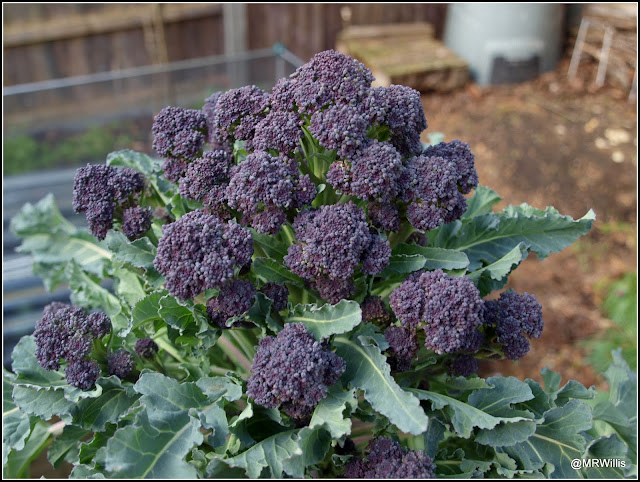Here they are, shortly after planting out, protected by netting against animals.
When I heard about the imminent severe weather, I covered them with my long cloches. Although Broad Beans will stand a few degrees of frost, I was afraid that they might be broken by heavy snow accumulating on top of them.
I was right to be worried. We had our heaviest fall of snow for several years. This photo was taken when the thaw had already begun.
Well, it seems the cloches did their job pretty well. The beans are fine.
No sign of any damage.
The first few leaves of my Rhubarb were killed off by the Beast From The East weather event, during which the temperatures were lower and the snow lasted longer. This time, the Rhubarb seems to have got off unscathed:
Meanwhile, the little Brassica and Allium seedlings have also survived all right, protected as they were by the big Gabriel Ash coldframe.
One of the few crops I am currently harvesting is the Purple Sprouting Broccoli.
The first variety to be ready was "Rudolph". This year I decided to be unconventional and not cut the tip of the plant first. Doing that is supposed to stimulate the production of spears lower down the plant. This one doesn't seem to need much stimulation. I have already picked 15 really nice big spears from it, and there are plenty more to come.
 |
| "Rudolph" |
The things we call "spears" are the flower shoots of the plant, and they grow in the leaf axils (i.e. between the leaves and the main stalk), just like Brussels Sprouts. In this next photo you can see where some have been harvested.
Many readers will know that I am growing four PSB plants, one of each of four different varieties, with the intention of having a longer harvesting period.
 |
| L to R: Early Purple, Red Spear, Red Arrow, Rudolph. |
The plan is definitely working. The "Rudolph" plant is probably good for another 2 or 3 pickings, by which time "Red Spear" will be ready to come on stream:
 |
| "Red Spear" |
Though not quite as big as "Rudolph" (which is about 4 feet tall), "Red Spear" is a big plant, and will yield a good number of spears.
 |
| "Red Spear" |
"Red Arrow" is a bit less well advanced, and will not be ready for about 3 or 4 weeks yet.
 |
| "Red Arrow" |
And ironically "Early Purple Sprouting" will be last of the four!
 |
| "Early Purple Sprouting" |
Hopefully within a few days I will be able to report my first planting up at the Courtmoor plot, which is scheduled to be potatoes (and possibly a few of the spare Broad Beans).










I do not comment very often , but I love reading your blog and I am so glad your protective covers were successful. I aspire to be the gardener you are. Thanks for taking the time to post. Lis
ReplyDeleteMusic to my ears! Thank you for these kind words.
DeleteIt’s one of the advantages of gardening just outside of your back door, You can respond to conditions quickly. Things growing on th allotment have to look after themselves as best they can. To make matters worse the more open environment offers little protection.
ReplyDeleteYes, that's very true. I expect I will experience some of this with my new plot. It's only about half a mile away, but it's still a bit far to just pop outside for a few minutes.
DeleteI went out to my tiny garden with a stick and knocked all the snow off my plants before the over night frost.
ReplyDeleteThat's a wise precaution. Shrubs and small trees are particularly vulnerable, because snow can snap their branches off.
DeleteHi, it's lovely to see such healthy looking plants, my over wintering brassucas never look appetising, they either seem very leathery (as in the case of my cabbage) or the leaves are begining to disintegrate (as in tge case if my sprouts) leaving me with good sprouts early on but not making it through to supply me with fresh greens. I don't think it's the weather (but i have tried protection anyway), maybe i am supposed to be feeding them, but with what and when (on my organic patch)? Overwintering broad beans seem to do just fine! Any idea?
ReplyDeleteMany thanks for sharing your veg
I feed mine with Growmore in the Autumn and then again when the spears begin to show - but Growmore is probably not organic! With the sprouts, why not try growing a number of different varieties? Some varieties are bred specially for late cropping, in Late Winter / Early Spring.
DeleteThe irony of the late "Early" variety is not wasted on me - that's the only one I am growing! Even with netting the pigeons attacked the tallest one through it. Don't you get pigeons? Great demonstration of successional cropping - I will be adding Rudolph to my seed supply. Thanks
ReplyDeleteI have been growing PSB for many years, and there was only one year when the pigeons showed any interest in it at all. I put netting over it to try to deter them, but they just sat on top of the netting and pecked through it!
Delete